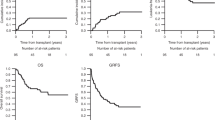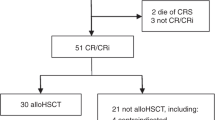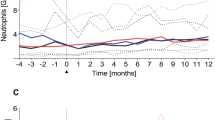Abstract
B-cell chronic lymphocytic leukaemia (CLL) cannot be cured by conventional therapy. To improve the prognosis of patients with CLL, we have designed a sequential treatment strategy that comprises intensive chemotherapy for mobilization of peripheral blood progenitor cells (PBPCs) and induction of minimal disease, followed by high-dose radiochemotherapy with stem cell reinfusion and post-transplant molecular monitoring by polymerase chain reaction (PCR) amplification of the complementary determining region III (CDRIII) gene. In a prospective study, we have evaluated this protocol in 18 patients with CLL, also including early stages of the disease. The median age was 49 (29-61) years; Binet stages were A, six; B, nine; and C, three. Adverse prognostic factors [high lymphocyte count and/or diffuse bone marrow (BM) infiltration] were present in 16 out of 18 patients. All patients showed a clone-specific molecular marker as demonstrated by PCR amplification of CDRIII rearrangements. For stem cell mobilization and reduction of tumour load, one to two cycles of Dexa-BEAM chemotherapy were administered, resulting in minimal disease (circulating lymphoma cells <1 x 10(9) l(-1); BM infiltration <20%; lymphomas <2 cm) in 16 out of 18 patients, including four patients who already had minimal disease before Dexa-BEAM. Stem cell harvesting was successful in 14 patients. All grafts [three BM, 11 peripheral blood (PB)] were purged from leukaemic cells using immunomagnetic methods. Thirteen patients having achieved minimal disease were reinfused with purged autologous stem cells (ASC) after preparation with total body irradiation and cyclophosphamide. Engraftment was delayed in patients receiving BM (n = 3) but prompt [neutrophils >0.5 x 10(9) l(-1) after 10 (9-13) days, platelets >20 x 10(9) l(-1) after 11 (9-214) days] in patients restored with PBPCs (n = 10). Procedure-related deaths did not occur. Although the results of CDRIII PCR suggest persistence or recurrence of the leukaemic clone in at least three cases, to date only one patient has relapsed, whereas all others survive without clinical evidence of disease with a maximum follow-up of 48 months. We conclude that sequential high-dose therapy using Dexa-BEAM and autologous stem cell transplantation is a safe and highly effective treatment for patients with CLL. However, a longer follow-up is needed to assess whether definite cures can be achieved using this strategy.
This is a preview of subscription content, access via your institution
Access options
Subscribe to this journal
Receive 24 print issues and online access
$259.00 per year
only $10.79 per issue
Buy this article
- Purchase on Springer Link
- Instant access to full article PDF
Prices may be subject to local taxes which are calculated during checkout
Similar content being viewed by others
Author information
Authors and Affiliations
Rights and permissions
About this article
Cite this article
Dreger, P., von Neuhoff, N., Kuse, R. et al. Early stem cell transplantation for chronic lymphocytic leukaemia: a chance for cure?. Br J Cancer 77, 2291–2297 (1998). https://doi.org/10.1038/bjc.1998.381
Issue Date:
DOI: https://doi.org/10.1038/bjc.1998.381
This article is cited by
-
Transplantation in chronic lymphocytic leukemia
Current Hematologic Malignancy Reports (2007)
-
Autologous stem cell transplantation in patients with chronic lymphocytic leukaemia: the Finnish experience
Bone Marrow Transplantation (2006)
-
The prognostic impact of minimal residual disease assessment after stem cell transplantation for chronic lymphocytic leukemia: is achievement of molecular remission worthwhile?
Leukemia (2005)
-
Mobilization of peripheral blood stem cells in CLL patients after front-line fludarabine treatment
Annals of Hematology (2005)
-
Comparative analysis of minimal residual disease detection using four-color flow cytometry, consensus IgH-PCR, and quantitative IgH PCR in CLL after allogeneic and autologous stem cell transplantation
Leukemia (2004)



